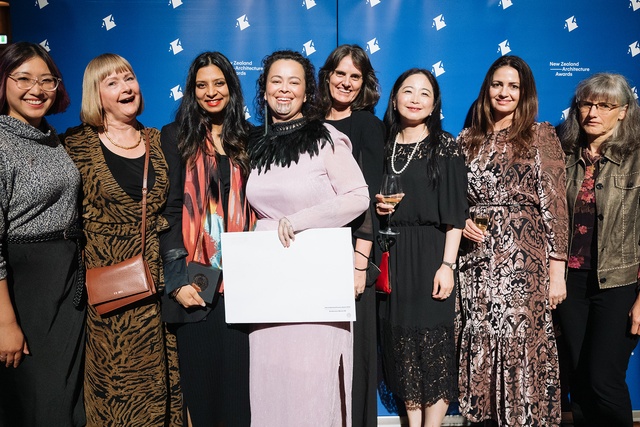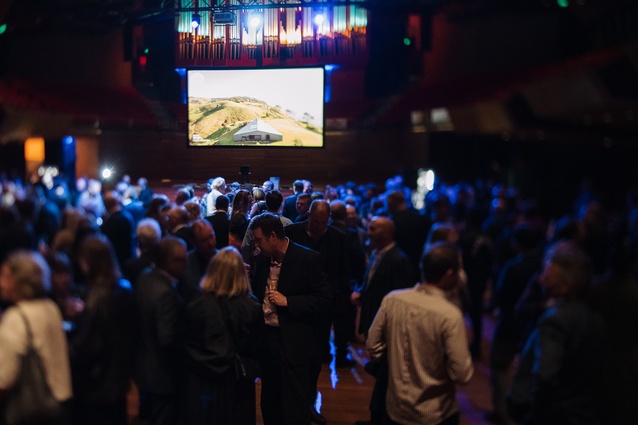Rethinking awards
Never in the history of architecture awards have so many clients thanked so many architects and so many architects thanked... everyone.
Perhaps it was the sheer joy of being together after years of Covid isolation. Perhaps it was asking too much this crazy year to keep the speeches brief. The 2022 Te Kāhui Whaihanga New Zealand Institute of Architects Awards presentation, at the Ōtautahi Christchurch Town Hall in November, was a welcome return to a sort of normal, as well as a bit of a marathon.
Still, it was nice to be together. Although I do wonder whether, in a time of climate crisis, flying people in from all over the country and causing untold CO2 emissions is the right thing to do. If we wanted to act responsibly, to show leadership in this most urgent existential crisis, we would cease such carbon-emitting gatherings. Despite Architects Declare and other well-intentioned initiatives to make a difference, we party on. Sure, everyone likes a party but I can’t help thinking the way we did the awards during Covid – localised branch events connected virtually – even if it’s only a drop in the bucket of reducing emissions, is what we should do.
As for awarding good architecture that cares for the planet, well, we’re not great there either. “Is there anything more pressing than the changing physics and chemistry of our planet, exposing us to forces beyond our control and time frames we cannot predict?” asked 2022 awards convenor Andrew Irving at the event. “To the 10 per cent of entrants who have used certification or science to assess carbon or energy use, thank you for being ahead of the curve. That leaves the 90 per cent of us, 90 per cent, who need to be carbon better.”
It’s a shameful statistic for a profession that should be at the cutting edge of building and begs a question: If 90 per cent of awards entrants are not using science to certify or calculate their buildings’ carbon footprints, why are they up for awards?
Any doubt about the urgency here can be dispelled by listening to United Nations Secretary-General António Guterres at COP27 in Egypt in November last year: “We are on a highway to climate hell with our foot on the accelerator.” We all know the building sector, accounting for 37 per cent of global carbon dioxide emissions (including the embodied energy of materials and the operational energy for running buildings), is a major cause of the highway-to-hell joyride. The 2022 UN Environment Programme’s Global Status Report for Buildings and Construction gives little cause for optimism.
In 2021, the sector’s energy consumption and emissions rebounded from the Covid pandemic to “an all-time high of around 10GtCO2, around 5 per cent up from 2020 and 2 per cent higher than the previous peak in 2019”. Overall, we have made less than half the progress we should have made on decarbonising the sector at this stage.
Addressing the elephant in the room, Irving called for action. “A sustainability statement and low-energy light fittings are not enough. We need to take this opportunity to show leadership as a profession and own this space that is changing how we design, how we construct and how we live.” Speaking truth to ambivalence.
Irving shared a further sobering statistic: “We reviewed about 165 projects awarded at branch level in finalising these awards: 85 of these, more than 50 per cent, were at the scale of a single residential dwelling, a typology that has moved from social right to a commodity increasingly beyond reach.”
He urged the profession to address another elephant in the room, the housing crisis. “We need to widen our gaze and apply this same skill and sophistication to projects at scale, or that are somehow innovating to meet this pressing social need.” Speaking truth to elitism.

The well-deserved inaugural recipient of the newly created John Sutherland Practice Award – Architecture+Women.NZ – highlighted another area where the profession is lagging. The organisation’s core aims are to achieve visibility and inclusiveness for women within the industry and to create equality across the profession. Receiving the award, one of the organisation’s co-chairs Lynda Simmons said: “We are very honoured to receive this award and want to add a reminder that you, the industry players, shouldn’t think that you are all off the hook – we will continue to be a thorn in the side of the profession”.
Bravo, because we all know that equity work is far from done. But Architecture+Women also shows how to achieve change in a seemingly intractable patriarchal profession. “The values that underpin this award are similar to the values that we prioritised when designing our own awards programme in 2014,” said Simmons. “And we hope that our effect may have rubbed off on the NZIA in the establishment of this important award.”
She’s talking about Architecture+Women’s Munro Diversity Award, which celebrates the “outstanding careers or practices which continually support and/or promote diversity in architecture, and… recognise the invisible work that goes into supporting the many and varied sectors of the architectural community.”
The rub-off effect was also evident in the organisation’s Chrystall Excellence Award, first given to Julie Stout in 2014, which undoubtedly prompted the NZIA to give her the Gold Medal in 2021. Stout was the first woman to be awarded it in the 21 years the awards have been running.
Thorn in the side. Rub-off effect. Architecture+Women.NZ shows how, with new forms of engagement – lobbying from the outside – change in the profession can happen. It’s good to see that, as we embark on 2023, there’s plenty of space for celebrating the way architects are innovating, beginning to really address the more urgent imperatives of “how we design, how we construct, and how we live.”
Related articles:
Architect Julie Stout awarded highest honour in New Zealand architecture
Obituary: Lillian Chrystall (1926–2022)











